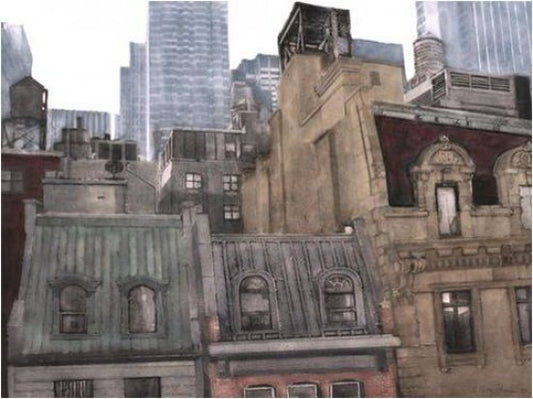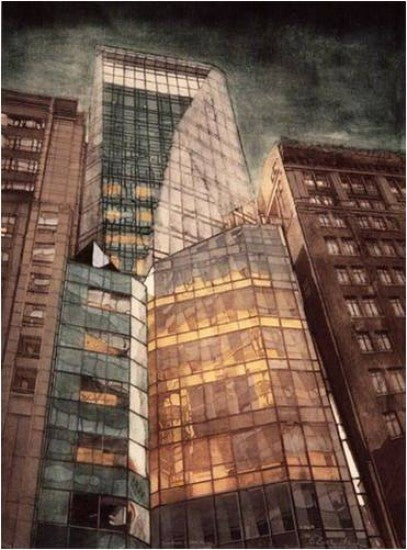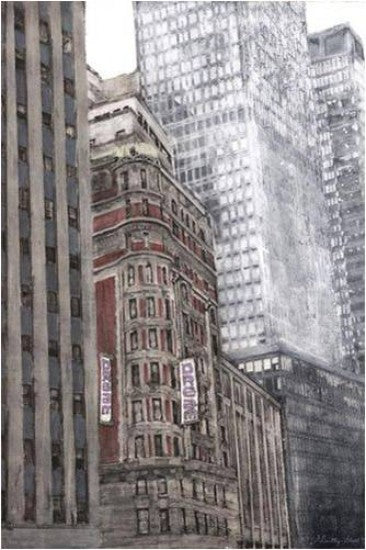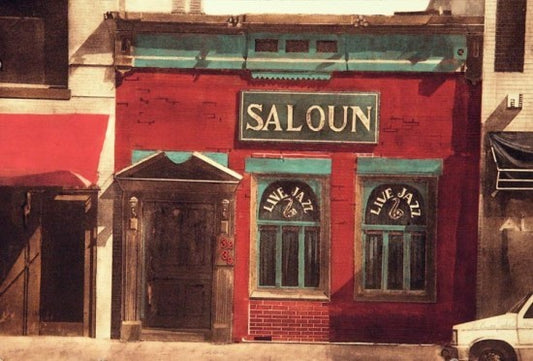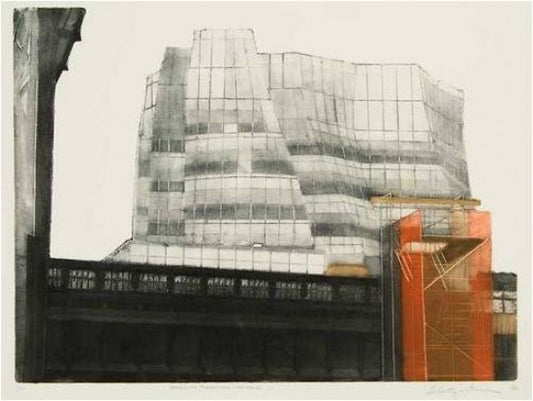Collection: Grace Bentley-Scheck
“When viewers ask how I make my prints, a friend tells them,” It’s magic.” Indeed, there is a magical quality to the process by which a drawing is transformed by the printmaking process into a new entity and the same image emerges from a plate each time it is inked. Printmaking imposes limitations which govern the choice of subject and encourage using the language of the medium to seek the essence of the subject. The daughter of a civil engineer, my fascination with the geometry of the urban space is my initial impetus in choosing subjects. The philosopher, Gaston Bachelard, said that buildings reverberate through time. Architecture, created by humans, is caught in the human cycle of birth, decay, and regeneration. Some buildings, like the Old State House in Boston, become stages for momentous events. Later generations seek to experience these sites of cultural seachanges. Other buildings shelter ordinary family or business activities and slowly adapt to social change and the natural aging process. In urban centers, such buildings often grow out of the debris of earlier cultures or stand next to buildings preserved from an earlier time. When the bulldozer breaks the ground of a city lot, it opens it to the future while excavating the past.
For many years, my work has dealt with architecture as space humans enclose which becomes dynamic via its passage through time. A sense of time is clearly understood at historic sites and is also seen in the process of renovation.. Most of all, passage of time is recorded in the marks left by functional changes made in structures over many years by human design or the elements and in changing patterns of light and shadow as the sun makes its daily journey across the sky. The process of building a collagraph plate layer by layer and the marks that result in the printing process have been evocative in expressing these subjects.” Grace Bentley-Scheck
-
"56th Street Harmony"
Vendor:Grace Bentley-ScheckRegular price $650Regular priceUnit price / per -
“City Nights-LVMH Tower”
Vendor:Grace Bentley-ScheckRegular price $650Regular priceUnit price / per -
“Live Jazz”
Vendor:Grace Bentley-ScheckRegular price $400Regular priceUnit price / per -
“Memories and Transformation - 10th Avenue”
Vendor:Grace Bentley-ScheckRegular price $500Regular priceUnit price / per -
“Morning Light - Lexington Avenue”
Vendor:Grace Bentley-ScheckRegular price $650Regular priceUnit price / per -
“Reflections on Providence”
Vendor:Grace Bentley-ScheckRegular price $650Regular priceUnit price / per -
“riding through a dream called endless summer”
Vendor:Grace Bentley-ScheckRegular price $650Regular priceUnit price / per -
“Vesuvio Bakery”
Vendor:Grace Bentley-ScheckRegular price $450Regular priceUnit price / per -
“Memories and Transformations – Chelsea”
Vendor:Grace Bentley-ScheckRegular price $700Regular priceUnit price / per -
“It Happened In Boston”
Vendor:Grace Bentley-ScheckRegular price $400Regular priceUnit price / per -
“Flatiron”
Vendor:Grace Bentley-ScheckRegular price $400Regular priceUnit price / per -
“Two Over One”
Vendor:Grace Bentley-ScheckRegular price $400Regular priceUnit price / per -
“Reflections on a Crosstown Vista”
Vendor:Grace Bentley-ScheckRegular price $350Regular priceUnit price / per -
“Manhattan Rising”
Vendor:Grace Bentley-ScheckRegular price $400Regular priceUnit price / per -
“Providence Curve-Thomas St”
Vendor:Grace Bentley-ScheckRegular price $450Regular priceUnit price / per -
“Memories & Transformations-W26thSt”
Vendor:Grace Bentley-ScheckRegular price Price on RequestRegular priceUnit price / per -
“Brooklyn Row”
Vendor:Grace Bentley-ScheckRegular price $200Regular priceUnit price / per -
“Memories & Transformations-Chelsea St”
Vendor:Grace Bentley-ScheckRegular price $400Regular priceUnit price / per -
“Empire State”
Vendor:Grace Bentley-ScheckRegular price $500Regular priceUnit price / per
